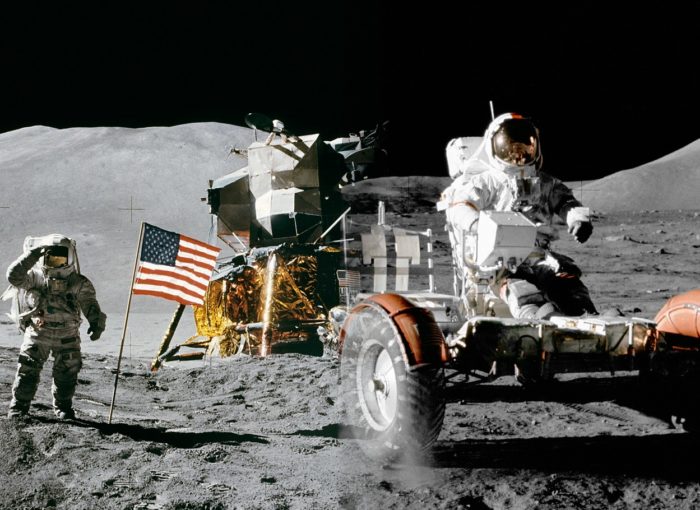
Close Calls And Controversy: The Last Hurrah Of The Apollo Missions
- By
- January 6, 2021
- September 29, 2021
- 25 min read
- 1
- Posted in
- Space, History
Following the successful Apollo 11 mission that landed the first humans on the Moon in July 1969, it was clear to all that the United States were the clear winners of the Space Race – at least the lunar landing arm of it.
The Apollo missions would continue for the better part of three years before landing missions on the moon were suddenly axed in favor of attempts to build a space station (something that would be achieved in the final years of the twentieth century).

The Soviet Union would persist in their attempts to reach the moon with their cosmonauts. However, their space program continued to be plagued with problems. In reality, all attention from the late-1960s and into the early 1970s was largely on the United States who, unlike the Soviets, went about their space business very much publicly and boastfully as they built up successful mission after successful mission.
The 1970s, though, would see increased cooperation between the two nations of the Cold War, which would, in turn, advance the possibilities for space exploration. And it could be argued that the success of the Apollo missions played a crucial part in those developments.
Contents
- 1 The Countdown Of The Apollo Moon Missions
- 2 Apollo 13 – The Mission That Wasn’t!
- 2.1 “We’ve Had A Problem Here!”
- 2.2 “We Are Venting Something Out Into Space!”
- 2.3 The New Importance Of The Landing Module
- 2.4 An Accident That Happened At The “Right Time!”
- 2.5 A Crucial Swing Around The Moon!
- 2.6 A Journey Observed By Billions
- 2.7 “A Failure – But A Successful Failure!”
- 2.8 Decisive Soviet Actions During Apollo 13
- 3 Apollo 14 – More Heart-Stopping Moments From Space
- 4 The Last Apollo Missions
- 5 The Importance And Uniqueness Of The Apollo Missions
The Countdown Of The Apollo Moon Missions
Less than six months after the successful Apollo 11 mission, on 14th November 1969, Apollo 12 prepared to launch from Kennedy Space Center in Florida. [1] On top of the Saturn V rocket in the Apollo command module were Pete Conrad, Alan Bean, and Dick Gordon, ready to embark on a mission that would see them emulate what their Apollo 11 colleagues had recently done.
However, before Apollo 12 even left the Earth’s atmosphere, the mission was thrown into a sudden emergency. It had been raining heavily on the day in question. However, there had been no lightning, so mission control saw no reason to delay the launch. As the huge rocket left the ground and made its way into the grey skies, things changed. The static electricity caused by the sheer size and power of the rocket, combined with the wet, rainy atmosphere appeared to become a catalyst for atmospheric electrical discharge.
Out of nowhere, a huge lightning bolt suddenly appeared, almost striking the launch site. Of more concern, especially to the astronauts themselves, was whether their vessel had sustained any damage. When the cabin was plunged into sudden darkness followed by an explosion of red warning lights, they knew it had.
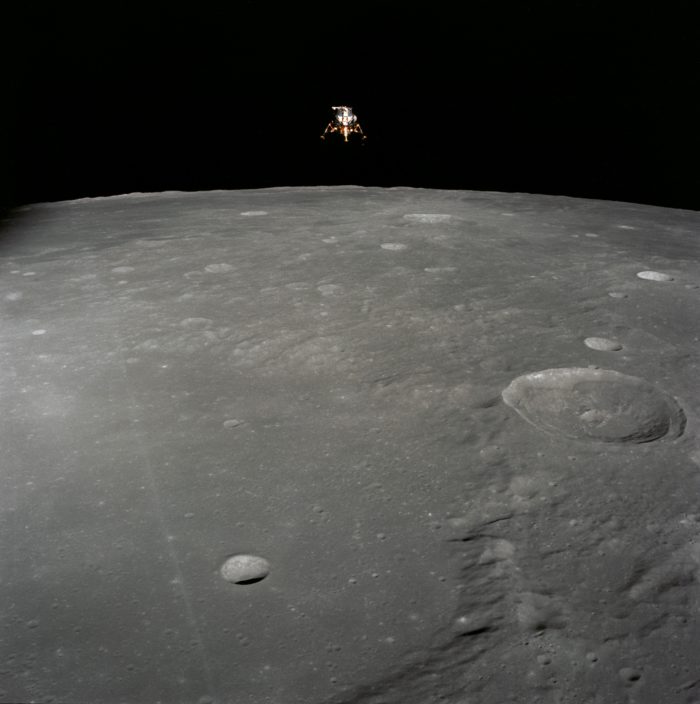
Conran informed mission control that they had “just lost the guidance platform” due to the lightning strike. However, back-up systems kicked in and power and function were quickly restored, much to the relief of the three crew members as well as those in mission control. Meanwhile, due to it running on a completely independent guidance system, the Saturn rocket continued with its task of taking the Apollo 12 into Earth orbit.
Shortly after, the process of restoring and reconfiguring the computer systems onboard the Apollo 12 began. Unless this process was fully successful, then the moon landing mission was suddenly in doubt. However, against the odds, it would prove exactly that, and Apollo 12 went for its lunar journey.
“Those Rocks Have Been Waiting Four And A Half Billion Years!”
Their destination was the Ocean of Storms, largely chosen due to its close proximity to a crater that offered scientists back on Earth the chance to study moon rocks millions, if not billions of years old should the astronauts manage to recover them. The location was already the site of several unmanned robotic missions from previous years.
The descent of the landing module began on 19th November – five days following their very eventful launch. Now, Conrad and Bean prepared to become the third and fourth people on the moon respectively. The landing itself was almost textbook. Much of the descent was undertaken under automatic control, with Conrad taking over for the final stage only.
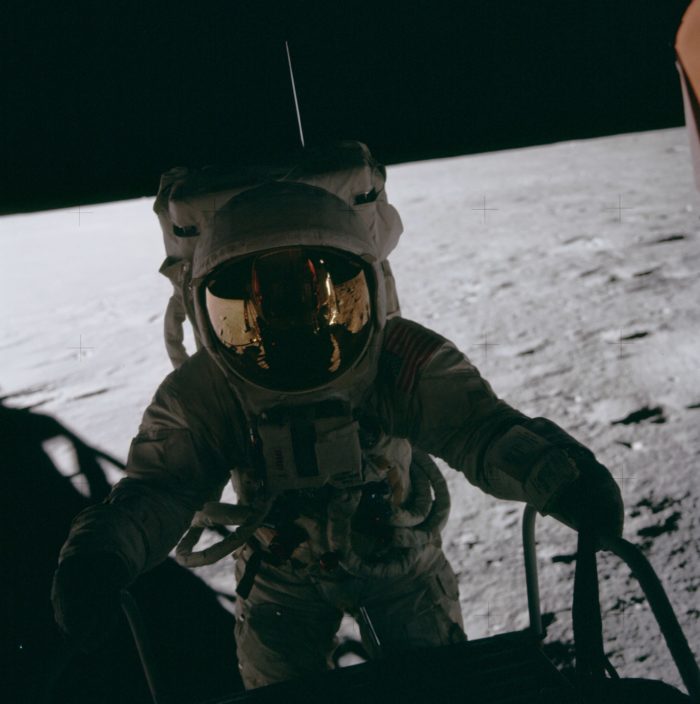
As he surveyed the lunar surface, eyeing the landing site, he brought the craft almost exactly where it was intended to land, having landed around 500 feet short of the actual target location due to the smoother surface which Conrad determined would be safer for landing. Upon touching down Conrad would state to mission control that he couldn’t “wait to get outside! Those rocks have been waiting four and a half billion years for us to come out and grab them!”
Conrad’s good mood and humor continued upon him leaving the landing module. As he dropped to the lunar surface, he quipped to mission control “that may have been one small step for Neil, but it was a long one for me!” in reference to him being the shortest of the NASA astronauts. Once he was joined by Bean, they went about very similar procedures as the Apollo 11 crew had several months earlier.
“Dust Got Into Everything!”
However, they would also report on things that were far different from the terrain that Armstrong and Aldrin had stepped on. Conrad, for example, would state to mission control that the “dust got into everything” and how a “pair of little dust clouds kicked up around” their feet whenever they walked.
In fact, because of the amount of moon dust that collected around the spacesuits, they would keep them on during their rest periods (they would perform two, four-hour lunar surface missions) so as to avoid moving the dust to key areas of the suits that could become clogged up.
It wasn’t just the state of the lunar surface that was different. The two astronauts also noticed “conical mounds” that appeared very much like “small volcanoes” as well as rocks that were a very distinct and different green color.
By the time they blasted off from the moon, sending a huge explosion of moon dust going in all directions as the lunar module ascended, Conrad and Bean had spent a little over 31 hours on the lunar surface.
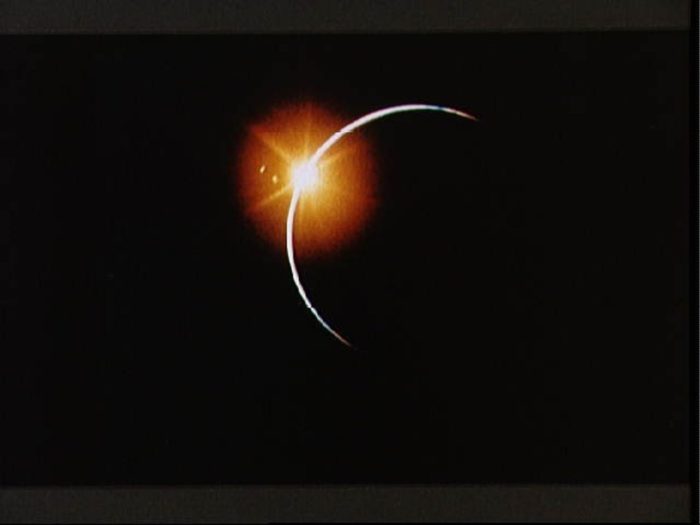
Following the successful docking of the lunar module to the main command module, yet another example of how smoothly the rest of the mission had gone following the initial problems shortly after launch, the crew would spend an extra 24 hours orbiting the moon taking as many pictures as possible of potential landing sites for future missions. They also managed to capture a rather iconic picture during their near-60-hour flight back to Earth when they witnessed the Earth eclipsing the sun (you can see that picture above).
They would eventually return to Earth on 24th November, splashing down in the Pacific Ocean near American Samoa before being picked up by the USS Hornet.
You can see footage of the Apollo 12 mission below.
Apollo 13 – The Mission That Wasn’t!
Although it didn’t land on the moon, the Apollo 13 mission would still see the crew (James Lovell, John Swigert, and Fred Haise) return to Earth as heroes. The mission launched on the afternoon of 11th April 1970 at a little after 2 pm (standard Eastern time).
In truth, although the real disaster would occur on the third day of the mission, there were problems right from the start when the second-stage engine shut down two minutes before it should have. This was caused by vibrations in the fuel tank and was something that NASA had been aware of since the Apollo 10 mission. However, due to the pressure to launch on time, the software that would have fixed the issue had not yet been incorporated into the Apollo 13 systems.
They would overcome the problem – essentially by having the third stage engine burn for longer – and they were on their way to the moon and their target location of the Fra Mauro crater. We should note, though, that when NASA investigated the data following the mission, they would discover that the flight was merely seconds away from a potentially tragic and fatal situation.
“We’ve Had A Problem Here!”
The next two days went without incident, as Apollo 13 made its way to its lunar destination. However, after having been in space for 56 hours and around 180,000 miles from Earth, things changed drastically.
After a standard day, Swigert flipped a switch on the control panel that switched on the fans in the tank containing liquid oxygen and liquid hydrogen which provided the Apollo vessel with electricity, water, and breathable air. However, unbeknown to Swigert, as he did so, two wires on one of the fans touched each other resulting in a spark that quickly turned into flames. This would result in a quick build-up of pressure which ultimately, around 90 seconds after the fans were activated, caused an explosion to rip through the tanks containing the vital liquid.
When the explosion occurred all three of the crew immediately heard the cacophony of twisting metal and flames, alerting them that something had gone terribly wrong. Just short of 30 seconds later, after communications had been restored, Swigert informed mission control that “we’ve had a problem here”.
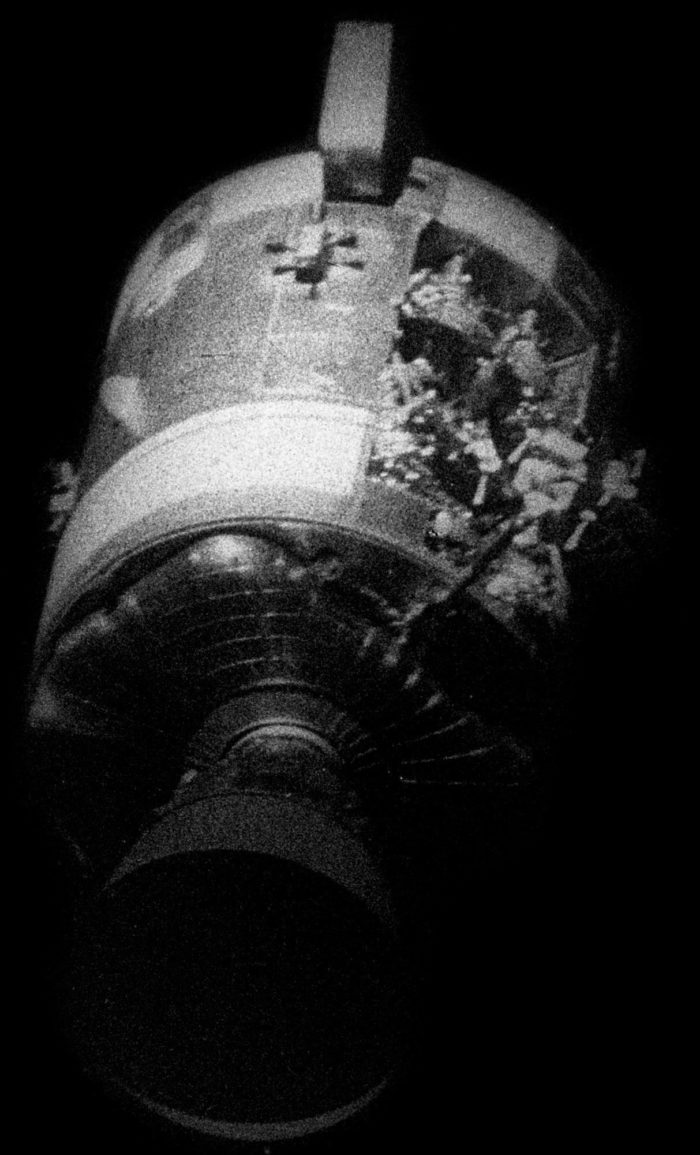
At first, Swigert contemplated whether they might have been struck by a meteorite but he and Lovell quickly dismissed this. When Lovell could see that Haise had no genuine idea what had happened, he also quickly dismissed the idea that Haise might have switched on the cabin-repressurization, which he had done previously as a joke on his crewmates given that it also made a similar loud bang when activated.
They would quickly realize that there was not enough voltage to provide the necessary power to the ship. As this was happening, shuddering vibrations were unleashed throughout Apollo 13, making the astronauts believe the entire craft was going to simply break up in the vastness of space.
“We Are Venting Something Out Into Space!”
Although they realized there was a problem with the voltage and so, in turn, keeping the liquid oxygen and liquid nitrogen at the correct temperatures (both hundreds below freezing), neither the crew nor mission control had any idea what the cause of the sudden problem was. So much so, that initially, it was hoped if the crew simply reset their systems, they would begin working as they should This, however, wasn’t the case, something relayed to mission control by Swigert saying “no joy”.
Lovell by this stage had ventured over to the porthole and peered outside. He almost froze at what he saw, knowing that whatever had happened, it was deadly serious. He would speak to mission control, informing them that “we are venting something out into space”. Both he and mission control could guess that those vital liquid gases were the “something” leaving the Apollo 13. And both parties realized that landing on the moon was now out of the question. Now, it was a battle to survive and return home.
Perhaps to get a good perspective on just how much vital “life” was oozing out of the Apollo 13, even amateur astronomers on Earth could view the visible cloud of gas, as well as debris from the explosion, in the skies overhead.
The New Importance Of The Landing Module
Back in mission control during this time, everybody available was working on just how to get the Apollo 13 crew home. However, when the second oxygen tank began to fail, things looked even bleaker for all involved, not least the crew themselves. Astronauts on standby were placed into simulators so as to play out the scenarios on Earth that were unfolding in space in an attempt to provide a fix or a way home. This was standard practice on all missions. However, the conditions had never been as intense.
The crew was ordered to run the ship at its most basic so as to save as much power as they could – as well as being able to keep communications open.
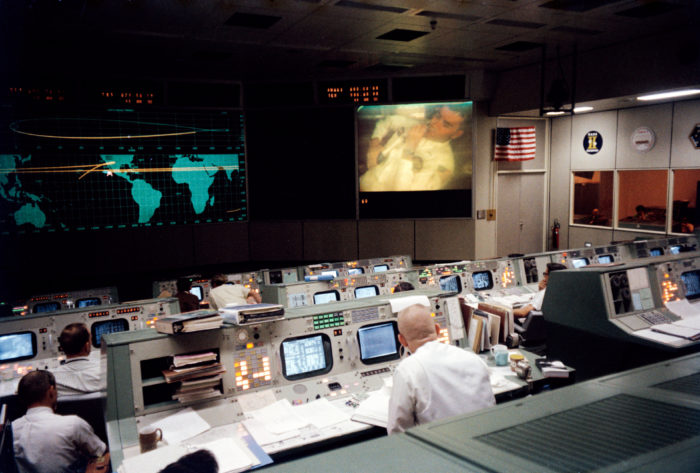
It would appear to those back on Earth that there were two main options open to them., None of which were ideal. They could, for example, attempt to turn the Apollo 13 around right where they were and then use what power was left to thrust them back toward home. However, it was determined that this option was “too risky” as they could not be sure of whether the burn of the thrusters would maintain for enough time to send them on their way, if at all.
With this in mind, it was decided the best chances of the crews’ survival was to allow it to loop around the moon and then begin its course back to Earth following the Apollo 13 coming around the other side, which would automatically have it on the correct route.
They would, though, still require an extra thrust in order to ensure a successful reentry. Realizing that the landing module was undamaged, mission control began to toy with the idea of using its, albeit, reduced power to provide this last, required burst of energy. They would perform this task in the simulators and ultimately concluded that it was possible. The landing module would, it would appear, be crucial to their successful return back to Earth. Not only as a source of thrust but as a makeshift space lifeboat.
An Accident That Happened At The “Right Time!”
The crew went to work immediately. Swigert would remain in the main command module, powering down the system, ensuring to place it into a hibernating state so they could restart the systems as they approached reentry. Lovell and Haise, meanwhile, made their way to the landing module and began preparations to house three crew members instead of two. They also had to ensure a way that carbon dioxide could escape the vessel given that the fans that would normally circulate the air were no longer working.
In order to do this, mission control would guide Swigert, aided by Lovell, through the steps to create a makeshift air purifier. Using a combination of cardboard, plastic, and tape, as well as pressures-suit hoses and an Apollo purifier, the last-minute, on-the-fly creation worked and dispelled the lethal carbon dioxide out of the landing module as well as importing fresh oxygen back into the cabin.
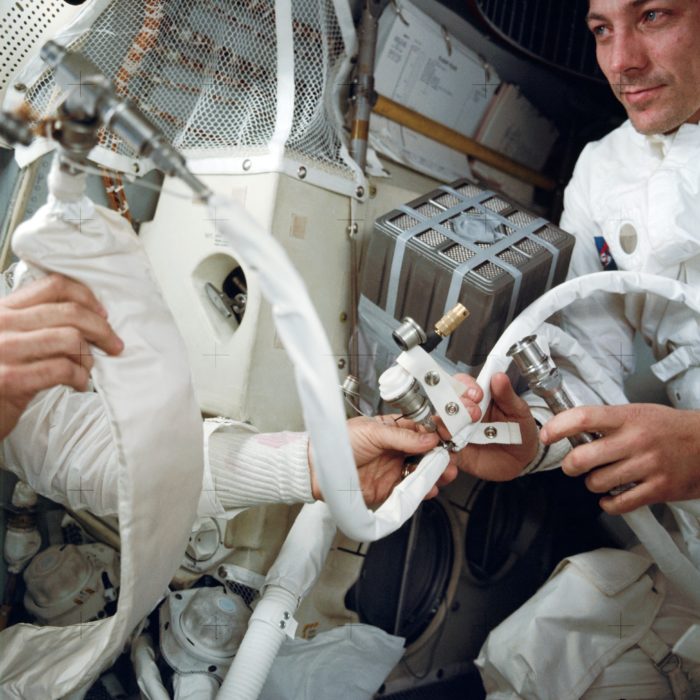
The realization soon came to those involved, that the accident had happened at exactly the correct time to give the astronauts their only chance of survival given that the lunar module was fully charged. More specifically, if the accident had occurred following the planned landing on the moon, they wouldn’t have even had the option to use the lunar module as the ascent stage would have been left on the lunar surface.
Once Haise joined his crewmates in the landing module, conditions became even more cramped, given that it was designed to snugly fit two people only. It was, though, the only chance to survive the sweep of the moon and the journey back home.
The sweep of the moon was a success. So much so, that both Haise and Swigert even took the time to take as many pictures as they could of the lunar surface below. Once they emerged, and with communications reestablished with mission control, the crucial part of the long journey back began.
A Crucial Swing Around The Moon!
The plan was to use the landing module engine to power them back to Earth – and those engines would have to burn for a long time. There were also further issues in that aligning the craft on the correct course could no longer be accurately done using stars for positioning due to the debris all around them. Because of this, Lovell used the sun to get an accurate alignment.
Upon receiving the order to do so, Lovell fired the engines of the landing module. To begin with he left the settings on manual control due to fears that further errors might occur. He would prove his skills, firing all engines available to him at exactly the correct moment. The Apollo 13 appeared to be on the correct course and heading back to Earth.
Then, however, another problem reared its ugly head. They realized that they didn’t have enough water (used for cooling the Apollo’s engine and computer systems) to get to their destination before they would run out. In fact, they would run out of water around five hours before they reached Earth. Lovell, though, would recall that the Apollo 11’s ascent stage had remained active and operational for around eight hours without water. It would be a risk, but it was their only option.
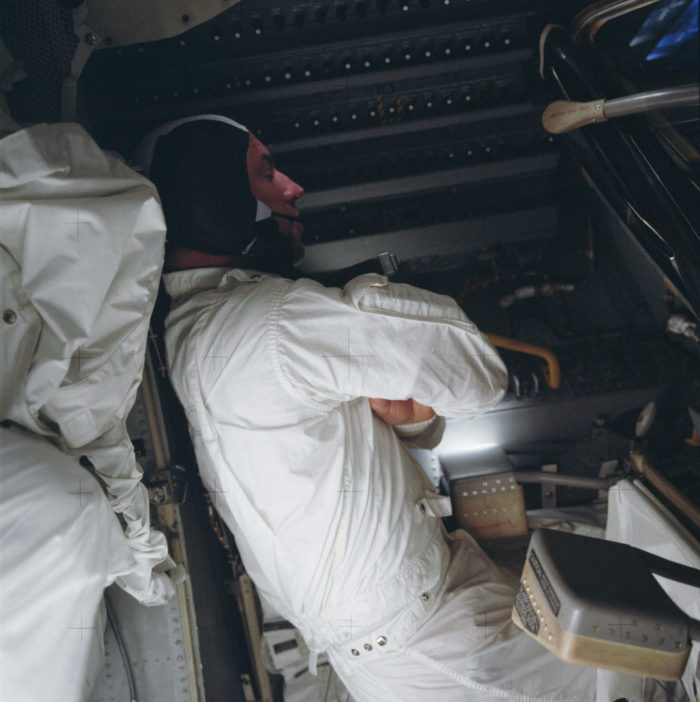
They would assume the landing module would survive without cooling for those last five hours, although they would begin restricting access to any water in order to conserve as much as possible.
The rest of the journey home, though, was far from comfortable for the astronauts. Unable to regulate the temperature, they spend most of their time in conditions only slightly above freezing. This was made worse by the fact that cold moisture was slowly building up inside the landing module. What’s more, they couldn’t wear their thicker spacesuits because of the lack of space inside the already cramped landing module.
These conditions would also make it much harder for the astronauts to rest and would ultimately lead to them becoming less and less alert. Back in mission control, the realization hit that they would have to somehow coax them into prolonged sleep ready for the reentry. They would eventually succeed and the cold, wet, hungry, and emotionally worn-out astronauts slept.
A Journey Observed By Billions
By 17th April 1970, the crew of the crippled Apollo 13 was approaching Earth and would attempt arguably the most difficult reentry in the history of space exploration. Initially, it appeared that they were very much on course for a successful splashdown in the intended location. However, the gas that was still leaking from the craft pushed them off-course. So much so, that they were in danger of leaving the atmosphere altogether and drifting back into space.
The only option open to them was to give the engines one last burst. Not even sure if there would be enough power in them, Lovell prepared to do just that. They fired for five or six seconds – just enough to set the Apollo 13 back on the correct course.
After what was quite possibly the most emotionally draining space flight ever completed, the astronauts would splashdown just off the coast of American Samoa in the Pacific Ocean. They were quickly recovered. Before returning to Houston, the three crew would make the journey to Hawaii where they were given the highest civilian honor from President Nixon – the Presidential Medal of Freedom.
Although they were largely unaware of it, their journey had been observed by millions (if not billions) of people around the world. Rather than being remembered as the crew that didn’t manage to land on the moon, they were clearly seen by many – especially the American population – as heroes.
You can check out the short video of the Apollo 13 mission below.
“A Failure – But A Successful Failure!”
The attention on the crew was intense, to say the least. Everyone wished to see the astronauts who had managed to do the impossible. To guide a spaceship back to Earth, with no fatalities, from the vast loneliness of space, thousands and thousands of miles away from home.
While the moon landing had not happened, just the fact that the three astronauts had survived what would likely have been the worst space disaster (at the time) was a miracle. Furthermore, although few mentioned it at the time, it was obvious to most that had the Apollo 13 mission ended in any other way (following the explosion), it would have all but guaranteed the cancellation of upcoming Apollo missions. In that sense, not only did the three crew members save themselves, they also saved the planned Apollo 14, 15, 16, and 17 missions.
Perhaps the mission was best summed up by Lovell himself who would state that “Our mission was a failure, but I like to think it was a successful failure!”
Indeed, it was.
There have been several movies and documentaries of the famous Apollo 13 mission. Perhaps the most well-known is the Tom Hanks film, Apollo 13, which was made 25 years after the events and was largely well-received around the world.
Decisive Soviet Actions During Apollo 13
Despite the Cold War still very much raging at the time of the Apollo 13 near disaster, as the space craft prepared to enter the Earth’s atmosphere, the Soviet Union, whether out of genuine concern or eager to avoid an international incident, took decisive action [2] in order to assist the astronaut’s re-entry.
One of the first things they did was to switch off all of their radio frequencies that operated in the same frequency band as the Apollo 13 so as not to create any interference whatsoever.
Furthermore, and decisively more active, they began to position various ships from their Navy in positions in both the Atlantic and Pacific Ocean. Essentially, if the Apollo 13 capsule came down anywhere near their positions, they were ready to go and retrieve them.
This action by the Soviet Union is perhaps a good demonstration of how the Space Race – as much as it allowed the two countries to flex their Cold War muscles in public – played a significant part in bringing the two ideologically opposed nations together. There is little doubt, for example, had the roles have been reversed and a Soviet craft was making an attempted, dangerous re-entry, the United States Navy would have taken the same action, and with the Soviet Union very much still in the Space Race at this stage, that possibility was a very real one.
Furthermore, although it was still several years away, the notion of the two nations collaborating on space missions was very much a reality, and such action went a long way in demonstrating the trust needed between the two nations – at least on a space exploration level. Although NASA would quite obviously rather the Apollo 13 incident hadn’t occurred in the first place, the event did perhaps go some way to strengthening that trust.
You can see a trailer from the film Apollo 13 which dramatized the intense events of April 1970.
Apollo 14 – More Heart-Stopping Moments From Space
On the evening of 31st January 1971 – around eight months after the Apollo 13 mission – Alan Shepard, Stuart Roosa, and Ed Mitchell prepared to launch in the Apollo 14 for the planned third successful moon landing.
Confident that the errors that had caused the explosion on Apollo 13 were fixed, NASA went ahead with the launch despite increasing cries to halt the program given that the United States had not only made good on President Kennedy’s promises but had also clearly beaten the Soviet Union in the space race to reach our cosmic neighbor.
Of course, to some, these were not reasons to halt such exploratory missions. Just one of these was Alan Shepard, who after becoming the first American to travel into space, had only recently been given the all-clear to fly again after several years of suffering from Meniere’s Disease (something which caused dizziness and nausea).
During this time, he was appointed the Chief of the Astronaut Office and was a key figure in the moon landings. However, surgery corrected this condition and Shepard was now chomping at the bit to reach the lunar surface. As happy as he had been for his fellow astronauts in their achievements, he was also envious that he would not get the opportunity. Now, that opportunity was about to unfold.
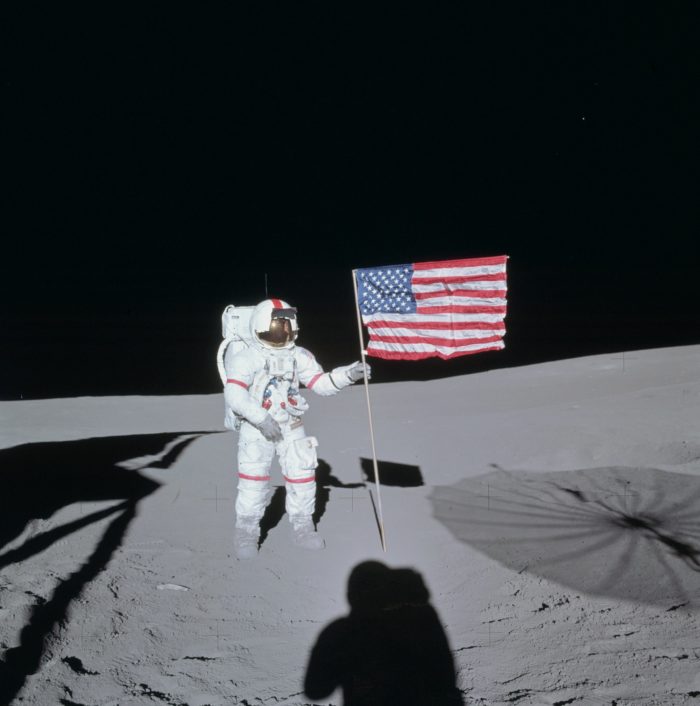
However, like the previous mission, the moon landing would be far from perfect or easy. And with the Apollo 18, 19, and 20 missions having already been canceled due to political pressure, Shepard, and all of those involved, realized that should the mission not be a success, the Apollo 15, 16, and 17 missions might suffer the same fate.
After a slight delay to allow a storm to pass overhead and head out to sea, the Apollo 14 launched from the Kennedy Space Center in Florida. As the plumes of flames of burnt propellent went in all directions, the Saturn V with the Apollo 14 on top began to rise into the night sky. Inside the capsule, Shepard was surprised at how “very smooth and strangely quiet” their rise into space actually was.
After orbiting the Earth several times, the Apollo 14 was finally cleared “go for translunar injection” – they were good to begin their journey to the moon. They fired their last stage rocket boosters and moved away from the planet at around seven miles per second. Their next stop would be the moon, and then the lunar surface itself.
An hour later, though, that feeling changed for everyone.
An Apparent Failure To Dock
Before setting off for the large part of their journey to the moon, the Apollo 14 had to dock with the waiting lunar module – something which was a standard procedure and had had no previous problems. However, on this occasion, that wouldn’t be the case.
As Roosa guided the Apollo 14 to its target, all appeared to be going well. However, when the green light to confirm a successful docking failed to show, despite having made what appeared to be a solid lock, an uneasy feeling began to spread through the Apollo 14 cabin, as well as the rooms of mission control back on Earth.
Permission to attempt docking again was given. However, once more, despite an apparent perfect connection, the docking failed to lock. They would make a third attempt, but with the same frustrating result.
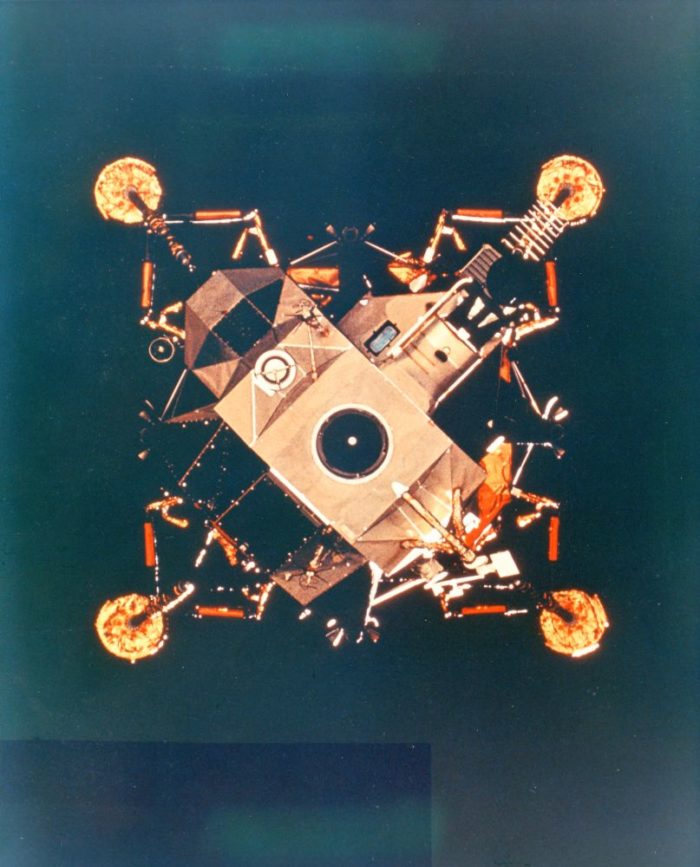
The consequences of this were clearly apparent to all involved with the Apollo 14 mission. If they didn’t manage a successful dock with the landing module, they would have to abort the mission to land on the moon. And coming off the back of the aborted (and near-fatal) Apollo 13 mission, the further, far-reaching consequences would be grim.
The crew inside the command module and those at mission control decided to pause for a moment and attempt to isolate just what the problem was. If they continued to make attempt after attempt, they would run out of fuel.
Fears Of Having To Abort
Much like they had for the Apollo 13 mission, stand-by crews leaped into simulators in an attempt to highlight what the problem might be. None of them could. Every attempt they made to dock was successful. Then, the idea was floated that there might be a piece of dirt that had become lodged in the locking mechanism. Even though this potential dirt could be tiny, it would still interfere with the locking mechanism. It was determined that if Roosa made several attempts then there was a good chance that whatever was blocking the lock would become dislodged. He would make several such attempts, but each failed.
Shepard – desperate not to have the mission aborted – would even suggest performing a spacewalk in order to manually clear the lock and pull the two vehicles together himself. Although this was briefly contemplated at mission control, it was ultimately viewed as much too risky.
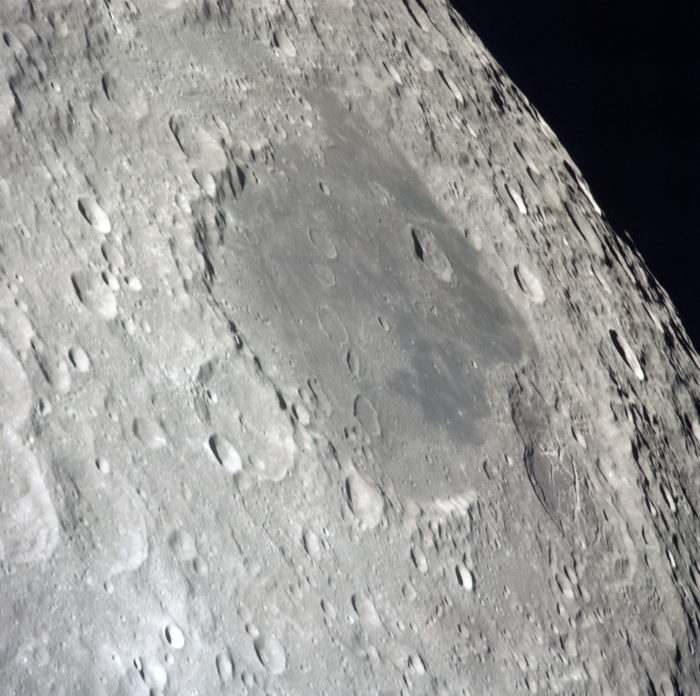
They would instruct Roosa to attempt another docking. This time, though, he should come in harder than a standard approach. Not only might this dislodge whatever was blocking the lock, it might even force it to lock as it should. Giving it much more power than was required, the Apollo 14 approached the landing module one more time. This time, it locked into place and the green light lit up to confirm.
However, despite this, and with the crew were already on their way to the moon, there was a sudden debate as to whether it would continue as planned. Not only was there now the issue of fuel, but there was a fear among mission control that even if the Apollo 14 crew did land on the moon, what if there was a similar problem redocking back to the command module after they had left the lunar surface?
The crew, amid attempts to rest and sleep, waited anxiously for further orders. Perhaps particularly, Alan Shepard.
A Fastly Created Fix
As they continued on their way to the moon, the astronauts waited to hear what their mission would be.
Shepard had all but made his mind up. If he had the chance, he would break protocol and land on the moon. Even if that meant docking the lunar module to the command module himself for the return journey. Of course, he had to keep these thoughts to himself. And, like the other crew members, wait to hear from mission control as the moon came ever closer.
Eventually, the orders came through. They were “Go” for landing on the moon. From there they continued on their journey, performing their scheduled tests and routine checks as they did so. By the 4th of February, they were ready to slip into lunar orbit. Shortly after, Roosa took the Apollo 14 to around 10 miles above the lunar surface and Shepard and Mitchell prepared to make their way to the landing module.
They would detach themselves from the command module and begin scanning the lunar surface around their target area (the Fra Mauro region) to find a specific place to land. They would remain in lower orbit for around four hours before Shepard finally saw an area to head toward. They began to go through their final pre-landing checks and prepared to begin their descent.
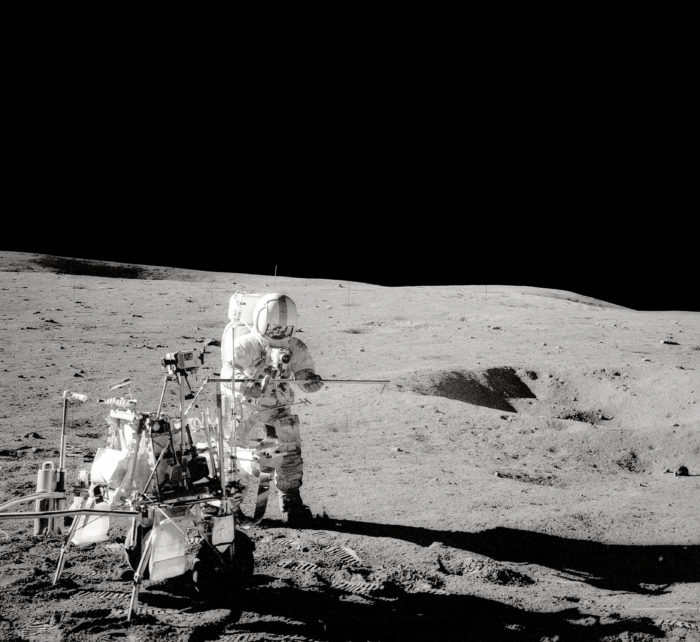
Then, something was wrong. Shepard informed mission control that the abort program had kicked in for unknown reasons. They would perform another simulated descent. Again, the abort program began. NASA began to believe that the abort signal was based on a false reading by the computer on the landing module. They would ultimately have to write a fix on the ground and then relay those changes to Mitchell in the lunar module so he could implement them. Essentially, these new commands made the automatic abort inactive meaning any decision, and subsequent action, was now down to Shepard.
Once satisfied that the program update was successful, attention turned to Shepard, and his attempt to finally land on the moon.
“It’s Been A Long Way, But We Are Here!”
Finally, they received their orders to “go” and Shepard began to take the landing module to the lunar surface. However, with the gray, dusty land heading toward them, their landing radar was not functioning. A lack of a landing radar would mean orders to abort.
As the descent continued, the radar continued to remain dead. Fearing that Shepard would attempt to land “blind” without the radar, mission control ordered them to reset the circuit. Much to their relief, this brought the radar back online. From there, Shepard brought the module to the surface of the moon. He informed mission control of the landing – almost perfect around 60 feet from their intended location.
As in previous moon-landing missions, those in mission control exploded into applause, as much in relief as in joy for the success of this part of the mission. Inside the landing module, Shepard and Mitchell looked at each other and shook hands. They had made it. Now, they began their wait to leave the module and step outside on to the surface itself. Finally, that order came.
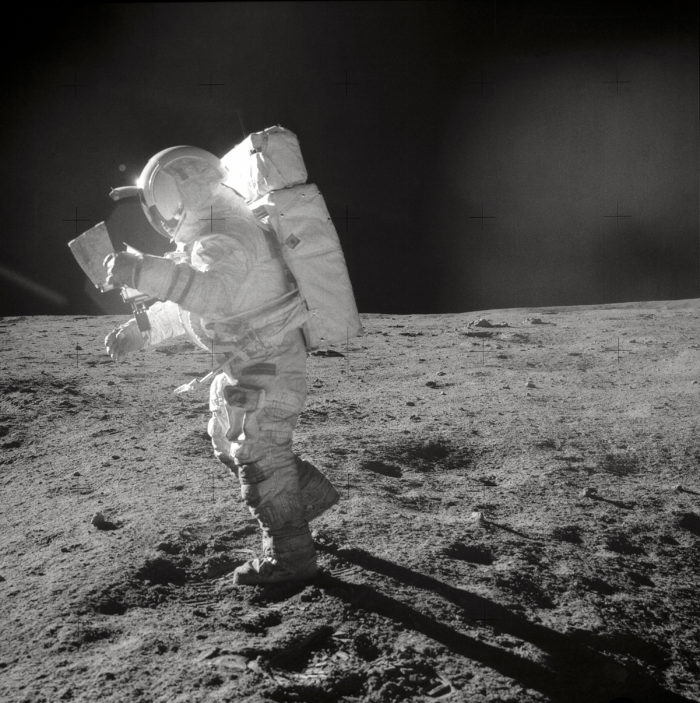
Shepard wasted no time in climbing down the ladder and drop to the lunar surface sending dust flying upwards as he landed. He would suddenly look around him at this desolate yet beautiful world. A world he had been in awe of for decades and now was finally stood upon. He looked at the mountain regions and the equally cavernous craters. After taking a deep breath and ensuring he appreciated every moment of this cosmic visit, he stated to mission control and the world, “It’s been a long way, but we’re here!”
It was apparent to many that those words not only referred to the long journey from Earth but the long journey since the beginning of the race to explore space. Of the Mercury and Gemini missions. Several moments later, Mitchell would join him on the surface after making his own way down the ladder of the landing module.
A Stark And Tough Place
The two astronauts would begin to get a feel for their surroundings. Mitchell would move quickly in order to see how his body reacted to the weak gravity of the moon. He would state that movement was “great” in such conditions, almost like bouncing.
Shepard, on the other hand, would turn his attention to the texture of the surface itself. He would describe it as “so soft, it comes all the way to the top of the lander module’s footpad!” He would further describe the Fra Mauro region as a “stark and tough place”, made even more so due to “the fact the sky was completely dark”.
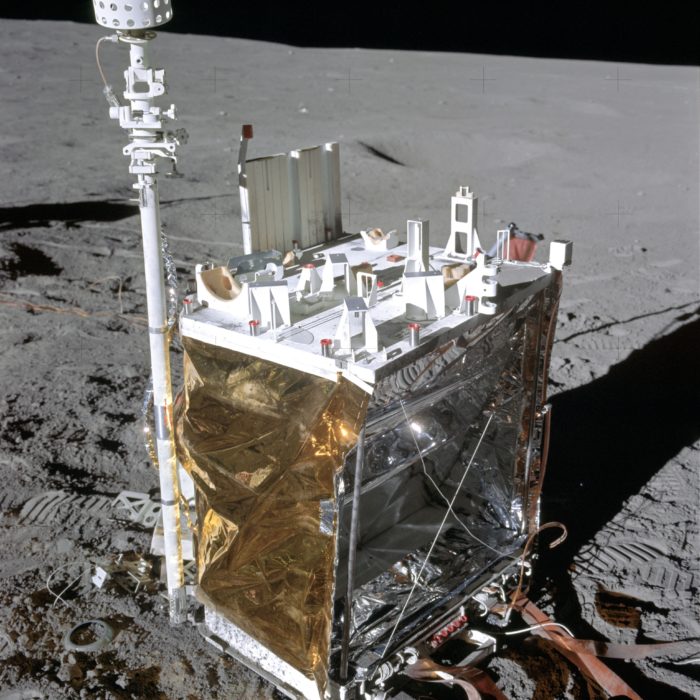
They would then begin collecting the usual samples of rocks and soil from the regions around the landing site. Unlike in previous missions, they had at their disposal a Modular Equipment Transporter (MET) – essentially a handcart that the astronauts could use to carry extra equipment, and even collected samples. They would also set up various pieces of equipment that would aid scientists back on Earth in further studies of this particular lunar region.
Each of their missions on the surface of the moon would last for over four hours, with each ending with them dragging their samples back to the landing module ready for transportation to the command module. The second of these would see them attempt to navigate a region named Cone Crater, something that the astronauts believed they would have “no trouble” achieving.
A Pleasingly Uneventful Journey Home
However, when they did make their attempt, they would find the terrain decidedly different to what they expected. For example, the MET struggled to move in the thick dust of the surface, forcing the astronauts to pick it up and carry it. The mission soon became increasingly desperate and draining. When they finally reached the mountainous side they would attempt to climb, Shepard would report that they would “take one step up, and you slip back half a step!”
Both of the astronauts were gasping for air as each step became increasingly harder. They would persist for a little longer but realized they were running out of time before having to return to the landing module. Eventually, despite their best efforts, mission control issued orders to abandon the climb and return to base.
Before returning to the landing module and preparing for take-off, Shepard would turn to the camera on the surface and alert mission control. He attached something to one of the lunar tools, which appeared to look like a golf club. He would then reach into his pocket and held up a golf ball which he let fall to the ground. His first shot “got more dirt than ball”. However, when he dropped a second ball to the ground and swung again, the ball sailed off into the distance of the black sky.
After having been on the moon for over 33 hours, the astronauts returned to inside the landing module, and after the usual checklists had been performed, prepared to blast off from the lunar surface.
An hour after leaving the surface, the landing module approached the Apollo 14 and prepared to dock. At mission control, everyone held their breath. This time, though, the link-up was perfect. They eventually detached the landing module and fired their engines in order to begin the three-day journey back to Earth. And this time, every aspect of the journey went perfectly and according to plan, right down to the splashdown in the South Pacific Ocean where they were eventually picked up by the USS New Orleans.
The below video looks at the Apollo 14 mission in a little more detail.
The Last Apollo Missions
Following the success of the Apollo 14 mission, the upcoming 15, 16, and 17 missions were all but guaranteed to escape the fate of 18, 19, and 20 and be canceled. These last three Apollo missions were classed as the “J Missions” and would be far longer than earlier moon landings with much more focus and extensive scientific research.
The first of these – Apollo 15 – would launch from the usual launch from the Kennedy Space Center in Florida on the afternoon of 26th July 1971 with Dave Scott, Jim Irwin, and Al Worden on board. This time, unlike the two previous missions the journey to our cosmic neighbor was without incident. Much was the same for the landing itself which saw Irwin and Worden step out onto the lunar surface.
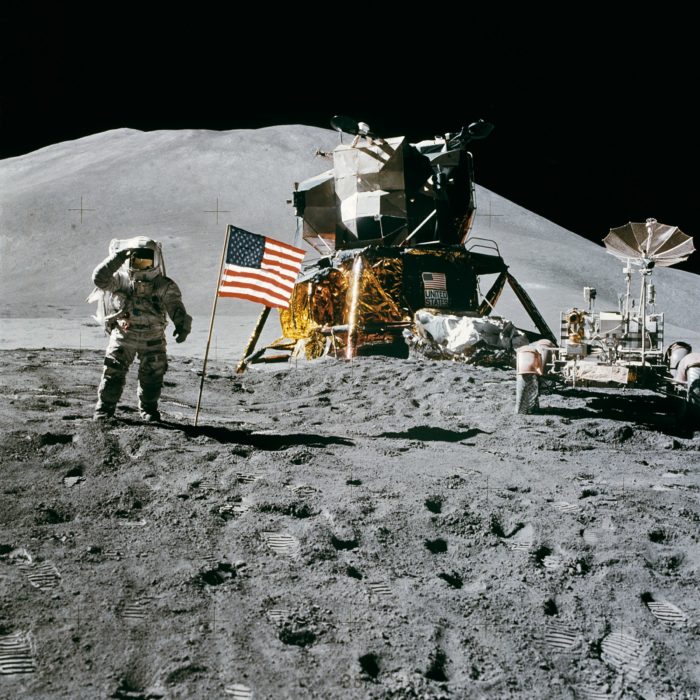
Their landing destination was the foothills of the Apennine Mountains, which towered a staggering 15,000 feet above the astronauts, dwarfing them. On the one side of the landing base that wasn’t stretching upwards over them was a gouge around a mile-wide named Hadley Rille. There was certainly much for Scott and Irwin to investigate.
The Apollo 15 mission is also perhaps memorable for the use of the Lunar Roving Vehicle (sometimes called the Lunar Rover or the Moon Buggy) for the first time. And given that this was an unforgiving terrain (including the mammoth slopes they would have to climb and come down), the two astronauts were more than glad to have it. Although it only moved at 11 miles per hour, to Scott and Irwin, they were simply flying along the lunar surface.
The Lunar Rover also gave the astronauts the opportunity to venture much further than previous astronauts – around six miles to be precise. This distance was decided upon in case the rover should suddenly cease to work as it was considered a reasonable distance for the crew to return to base from without exhaustion or the risk of running out of oxygen.
In total, the astronauts would spend just over three days on the lunar surface, as well as over 18 hours outside of the module performing extensive scientific missions.
However, even on the return back to Earth, the Apollo 15 mission managed to bag another first when Worden ventured outside the vehicle as the first spacewalk so deep into space unfolded. He did so at a staggering 197,000 miles from home, in an effort to retrieve film tapes from the SIM (scientific instrument model) bay.
Once they reentered the Earth’s atmosphere the only real snag of the mission occurred when one of the parachutes on the command module failed to unfold. However, the splashdown still went by without issue or further incident. The mission had been a resounding success.
You can check out the video of the Apollo 15 mission below.
Apollo 16 – Exploring The Descartes Mountains
The final two Apollo missions would both take place in 1972. The first of those – Apollo 16 – would launch from the Kennedy Space Center on the evening of 16th April 1972. This time, John Young, Charles Duke, and Ken Mattingly crewed the mission.
Young and Duke would land in a clearing at the foot of the Descartes Mountains, and after spending the first day in the module undertaking various duties, they would emerge on to the surface and begin performing many similar experiments as the Apollo 15 crew had done. In fact, they would gather over 200 samples in total, a haul that more than pleased scientists back on Earth.
Some of those samples contained chemicals that not only intrigued scientists but very much surprised them leading to a much wider understanding of our cosmic neighbor.
They would spend a similar amount of time on the moon as Irwin and Worden had the previous year. However, they would be outside of the landing module for over 20 hours, around two hours more than the Apollo 15 astronauts, spread out over three different lunar surface missions.
Another spacewalk was performed on the return journey – this time by Mattingly – who would retrieve the all-important cassette tapes from the scientific instrument module. They would splashdown successfully in the Pacific and awaited retrieval. In a little over six months, the Apollo missions would officially come to end. There was, though, one last mission.
Before we look at that, however, the short video below looks at the Apollo 16 mission a little further.
Apollo 17 – The Curtain Call Of The Moon Missions
Although most people at the time would have fully suspected that other missions to the moon would take place in the future, certainly before the end of the twentieth century, the last manned mission to the lunar surface would launch from the Kennedy Space Center on the afternoon of 7th December 1972. Gene Cernan, Ronald Evans, and Harrison Schmitt were on board for the journey, as well as five mice who would be part of several scientific experiments the astronauts would undertake.
This time, they would land their module in the Littrow Valley of the Taurus Mountain region of the lunar surface allowing them to explore yet another part of the moon.
Like the previous J Missions, Cernan and Schmitt would have access to the lunar rover, allowing them to cover a considerable distance from their base and gather further rock, soil, and boulder samples. They would also set up several technical devices on the moon’s surface in order that experiments could be conducted back on Earth.
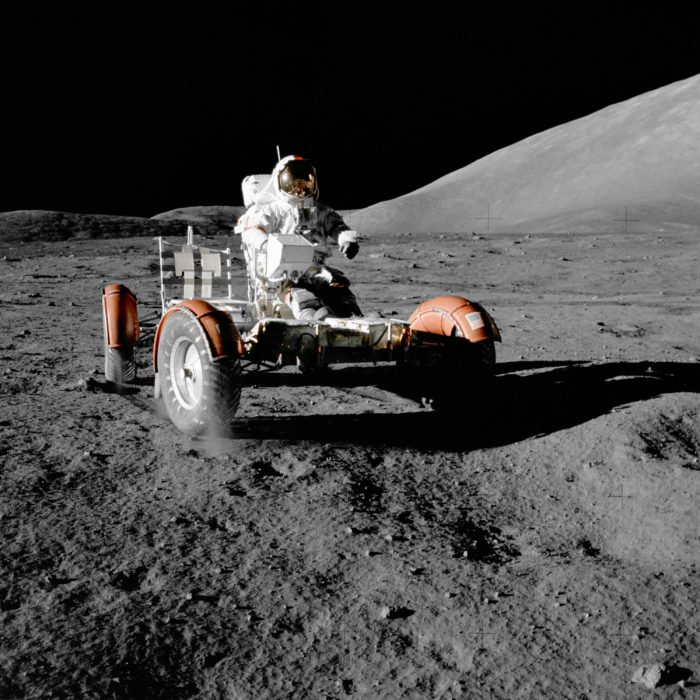
The two astronauts would spend a little over three days on the surface, with over 22 hours spent on the actual surface outside of the landing module (the longest of all the moon landing missions). And like all of the Apollo missions, but perhaps especially the J Missions that were Apollo 15, 16, and 17, their extensive experiments contributed a wealth of knowledge to our collective understanding of the moon.
The third spacewalk while in transit took place on the journey home, which went by without incident, including a successful splashdown in the Pacific Ocean before being recovered by a military helicopter.
The moment must have been tainted with a little bitterness. There were no further moon missions to turn their attention to for NASA’s scientists and astronauts. The end of the Apollo program had arrived.
The video below examines this final Apollo mission a little more.
The Importance And Uniqueness Of The Apollo Missions
While the Apollo missions certainly established the United States as not only the winner of the Space Race to reach the moon but also for space exploration for decades to come, the further-reaching consequences of them were of much more importance.
As we will examine in our next look at the history of space exploration, the moon missions would lead to a softening between the two nations, not only through the space programs but politically (albeit the latter came at a slower pace). What was unthinkable before the moon landings would become reality less than a decade after them when a joint mission in Earth orbit between the United States and the Soviet Union took place and the first seeds to joint exploration of the stars were sewn.
It also proved that, by and large, humanity could do and go wherever it chose to. Extensive explorations of Mars, for example, would not have succeeded, or even have gone ahead, without the success of the Apollo program. Nor would we know what we know of Venus, or the gas giants and their intriguing moons, some of which very well could prove habitable for humans should they ever land there.
Indeed, many firmly believe that the ultimate key to human survival will depend on our ability to venture into the great beyond and colonize one or multiple cosmic bodies. And while that might not happen in our lifetime, it is something that scientists are already seriously looking at, as are private organizations.
Whether such colonization occurs remains to be seen. However, when the timeline is traced back, the Apollo missions will be viewed as an important and historic, destiny-changing event.
The video below examines the Apollo program a little further.
References
| ↑1 | “Live from Cape Canaveral”: Covering the Space Race, from Sputnik to Today, Jay Barbree, ISBN 9780061 735899 |
|---|---|
| ↑2 | Why Explore Space?, Dr. Ernst Stuhlinger, Meaus http://www.meaus.com/whyExplore.html |
Fact Checking/Disclaimer
The stories, accounts, and discussions in this article may go against currently accepted science and common beliefs. The details included in the article are based on the reports, accounts and documentation available as provided by witnesses and publications - sources/references are published above.
We do not aim to prove nor disprove any of the theories, cases, or reports. You should read this article with an open mind and come to a conclusion yourself. Our motto always is, "you make up your own mind". Read more about how we fact-check content here.
Copyright & Republishing Policy
The entire article and the contents within are published by, wholly-owned and copyright of UFO Insight. The author does not own the rights to this content.
You may republish short quotes from this article with a reference back to the original UFO Insight article here as the source. You may not republish the article in its entirety.
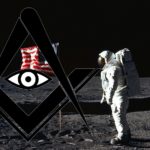
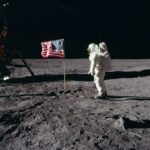
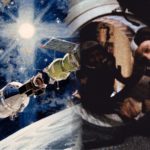
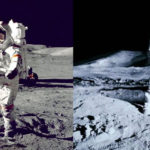
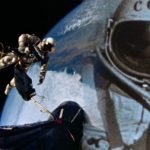
1 Comment
UFO Insight does not take responsibility for the content of the comments below. We take care of filtering profanity as much as we can. The opinions and discussion in the comments below are not the views of UFO Insight, they are the views of the individual posting the comment.
Newest comments appear first, oldest at the bottom. Post a new comment!
EXCELLENT ARTICLE BUT I FOUND MOLD ON THE BOTTOM OF THE MODULAR EQUIPMENT TRANSPORTER AND STAGE LIGHTING ON THE SIDE OF THE BOX…ALSO LOOKS LIKE THE ROVER IS STILL IN ITS CONTAINED ON THE LANDER BUT A ROVER IS SITTING NEXT TO THE LANDER……